By Barry Morrison
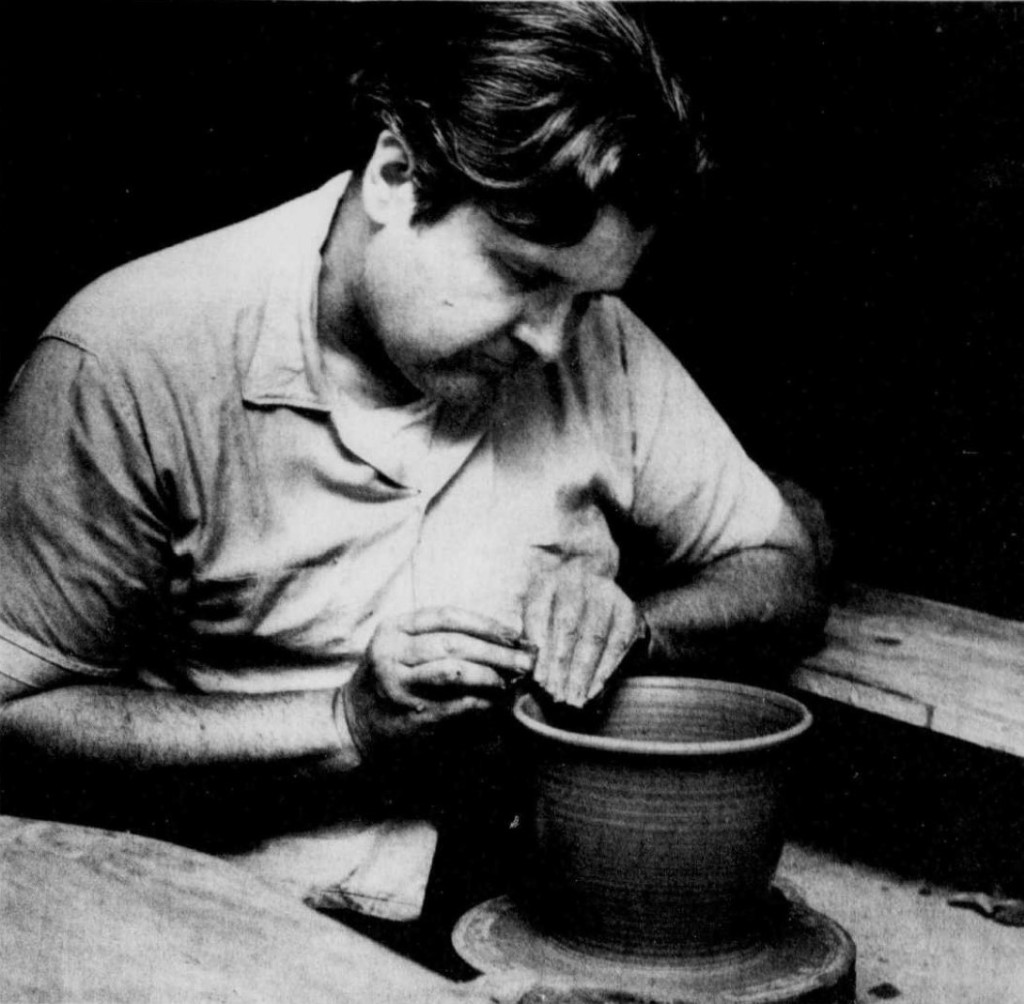
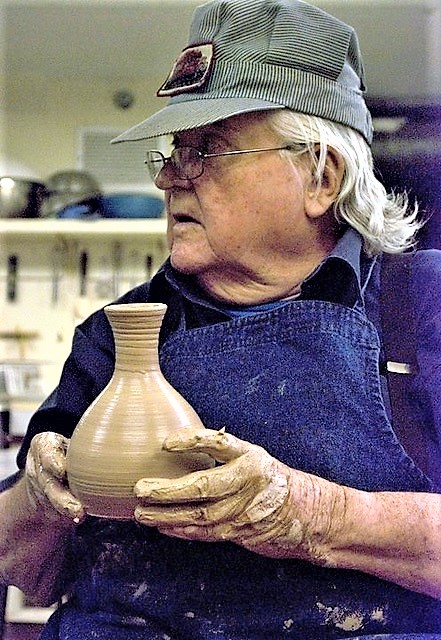
Capsule:
- Dates: 1927-2015
- Production Dates: 1951-2015
- Location: Various locations in the United States; North Hatley and Lennoxville, QC
- Types of Work: Functional
- Preferred Kiln Type and Firing Process: Mostly wood and gas firing; occasional salt kiln firing when visiting other potters (e.g. Ojai); some electric firing in his later career;
- Preferred Clay: Stoneware; occasional porcelain
- Signature/Mark/Chop: There is a variety of signature and mark combinations but they are quite easy to locate and interpret. Many also reflect, not the date, but the studio location, and by extension the artists with whom he was working at the time.
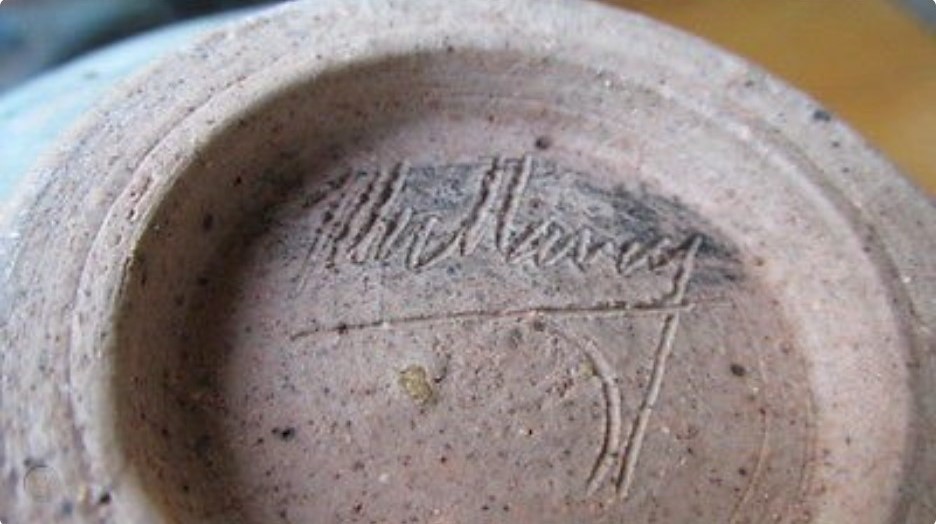

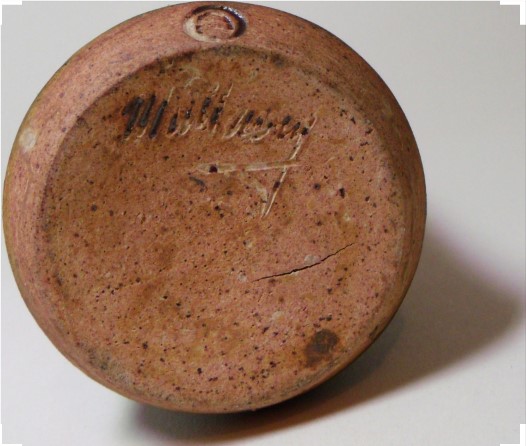
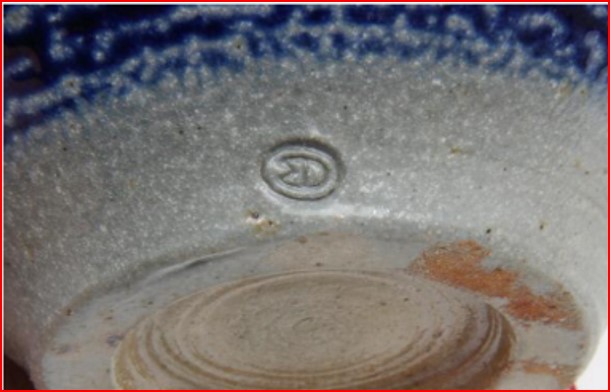
Various signatures and marks such as “Ways Mills” or “OJAI” in addition to his chop reflect his somewhat nomadic approach to working in friends’ studios. Ironically although he stressed studio management in his teaching Mullavey never really set up or owned his own studio.
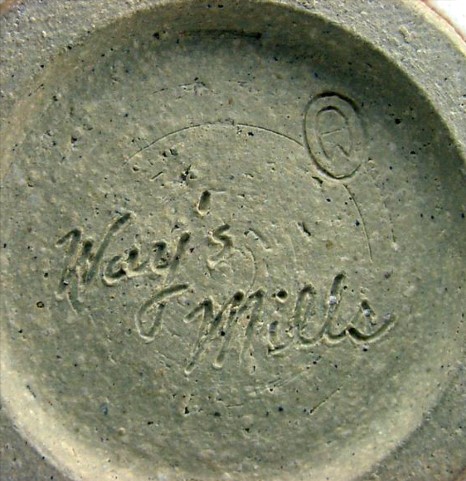
” A great friend of Stanley Rozynski and Wanda Rozynska, he resumed his art for some time at the studio-school of Way’s Mills, at the beginning of the 2000s, following Wanda’s invitation: ‘How about we make pottery again?’ she simply launched on the phone, inviting them to come out of their respective retirement and create ceramics for fun.” 21
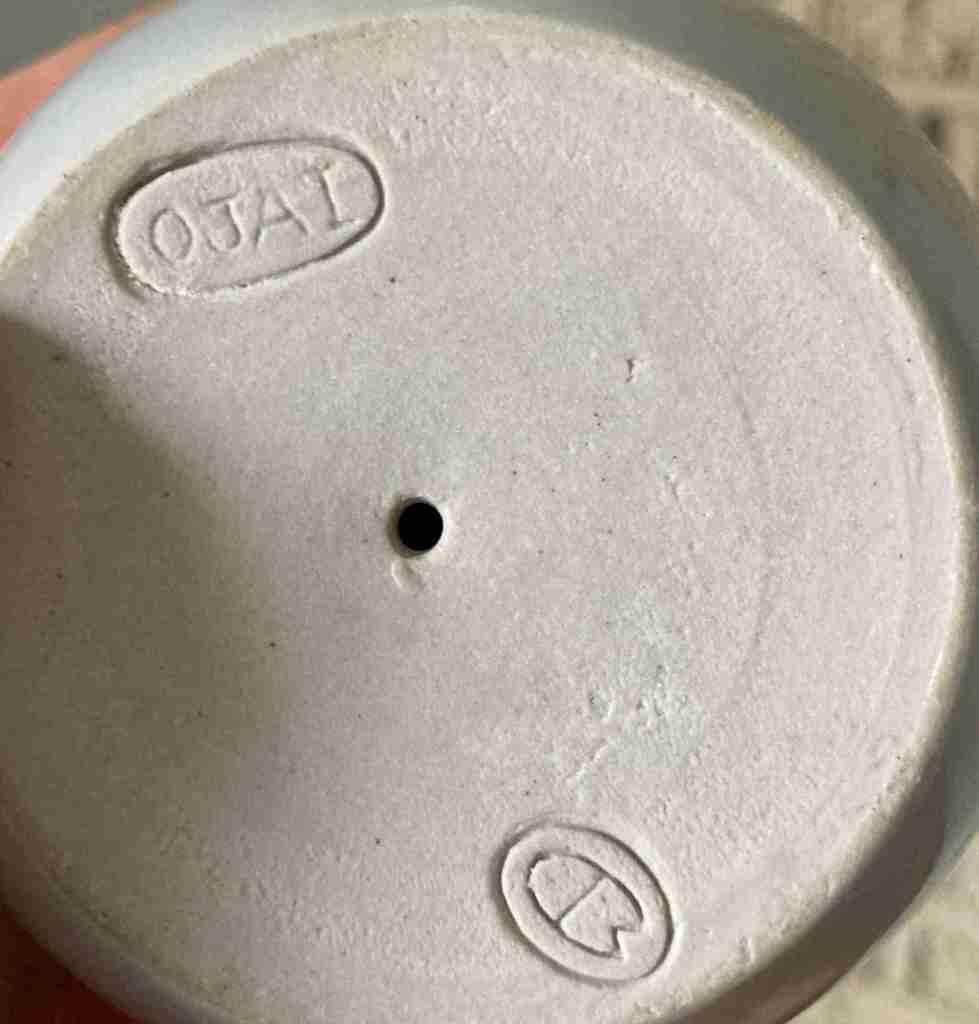
The OJAI stamp, probably designed by Mullavey himelf, indicates a firing while visiting the Heinos in California and fired in their Beatrice Wood kiln.
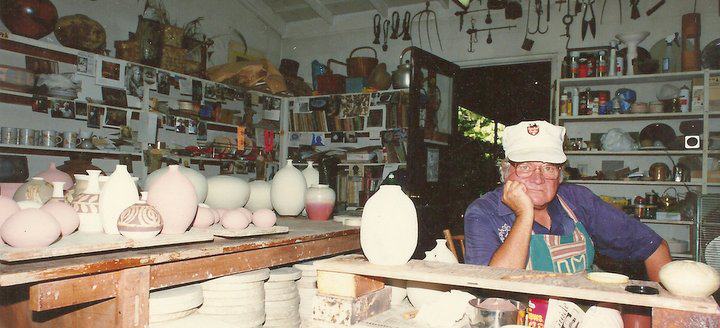
“… at the studio of the late Vivika & Otto Heino in Ojai, Ca. I spent quite a few summers there during the early 1990s. I rarely smile when being photographed, but you have to take my word that when this picture was taken I was so happy and privileged to be allowed to work and share a studio with Vivika & Otto. … Can you believe I have never had a studio of my own…I’ve always shared space with others.” 11
He proudly focused his talents on being a maker, and teacher, not a studio maker or builder.
Biography:
Foreword
This is an article about an artist, one much respected, even loved by his students and fellow ceramists, Dean Maxfield Mullavey. But it is also partly a story about a place, The Pottery, in North Hatley, Quebec, that links back to Gaetan Beaudin, and to his wife, Mildred. The time, the place, the people left a mark on many students and potters that resonates still among those who were fortunate enough to be part of it.
I must confess that I had intended to include a page on Dean much earlier in this website’s history and had correspondence with him back in the very early 1980s. But the number of artists—whom to include, when, and how—meant an opportunity for more personal contact was missed. But more recently, surprisingly and randomly, a number of his students, collectors and associates enthusiastically contacted me, suggesting I do a page on Dean. Random coincidence, synchronization, or serendipity? So please enjoy this article on Dean Mullavey.
The Early Years, in the United States
Like many artists early in their career Mullavey was mobile, teaching and still learning, across the U.S., and even in Japan. Spoiler alert: this would change once he moved to Quebec, Lennoxville and North Hatley. More of that below. Yes, he would travel widely, but Quebec would become his base.
His early learnings left essentially permanent marks on him, both aesthetically and in his attitudes towards teaching and student learning. These early years were also times of many schools and teachers; many of the names are not familiar to most Canadian ceramist and collectors.
I’ll try and connect as many of the dots I can. It would be easy to merely list his academic credentials in a list but that would be too dry.
In 1948 Mullavey was a twenty-one year old, Concord, New Hampshire, young adult, recently honourably discharged after three years service in the U.S. navy. He had served in the Special Services, stationed for a time in Japan.
In the summer of 1951 he started classes at the University of New Hampshire with Adrian Edwin Scheier. Scheier’s sgraffito designs were to be one of the many influences on Mullavey’s work and style.
Next, he studied with Ruth Randall, graduating in 1952, magna cum laude, with a BFA in Art Education from Syracuse University. This experience inspired him to take further studies in ceramics.5 From Randall and the Syracuse collection of Japanese pottery he would draw inspiration. Teaching was to become a key part of his life and source of income.
In 1954 he graduated with an MFA in Ceramics from, Tulane University, New Orleans, studying under Katherine Choy. Choy founded the Clay Art Center, Port Chester, New York, in June 1957, a cooperative studio where Mullavey continued his work on a mature level.
Mullavey acknowledged Choy’s influence on him:
“ … a remarkable person and superb craftsman. I believe I owe everything to her continuing inspiration.” 5
From 1957-61 he was also a teacher of pottery and art history in such places as the University of Virginia and the Brooklyn Museum School of Fine Arts among others. 10
Until 1961, wherever he worked and studied in the U.S, he exhibited extensively including the 16th and 17th Syracuse Ceramics National Exhibitions of 1951 and 1952, and internationally at the 2nd International Ceramics Exhibition, Ostend, Belgium, in 1959.10 In short, he cast wide his net of learning, creating and teaching.
These early years saw the foundation of his philosophy. His approach, though demanding of and for his students, was the result of a deep commitment to those influencers—his teachers, mentors and contemporaries—he acknowledged throughout his career.
The Quebec Years (1961-2015)
Although he came to Canada to teach art, art history and pottery there was an historical family link, a history with Quebec. His, like many families in Quebec and eastern Canada had a quite common cross-border flow of family relations and histories with New England:
“The Mullavey family came to Canada in the1820s from Fermanagh County in Ireland…my grandfather, Edward Mullavey was born in St. Patrice de Beaurivage in 1847 and emigrated to the US in the late 1800s. He married Alice Maxfield and my father, Christy Edward Mullavey, was a product of their union, and that’s how it all started!” 7
St. Patrice de Beaurivage is approximately 60 km south of Quebec City, and about 170 km northeast of North Hatley
However, although he continued to travel widely over the years, he never left the Quebec-based focus of his career for long periods. Surprisingly he gave relatively few workshops outside of Quebec.
Economics found him searching for new teaching and creation vistas. The 1960s were pivotal years for his Canadian experience and reputation. Now a short bit of resume listing:
- 1961-62 Lecturer, History of Fine Arts Bishop’s University, Lennoxville, QC10
- 1964-65 Pottery Instructor, l’Institut des Arts Appliqués, Montreal
- 1964-78 Summer session Pottery Instructor, The Pottery, North Hatley QC
- 1974-1995 Professor of Fine Arts, Champlain Regional College, Lennoxville, QC 10
These thirty plus years, cemented his reputation as a key figure in Canadian ceramics. So much so that he achieved an almost iconic status, especially in Quebec. He became a Canadian citizen in 1978.10
Mullavey rapidly started exhibiting and winning prizes: with the Canadian Handicrafts Guild in 1961, at Canadian Ceramics ’67, the Canadian Youth Pavillion, Expo ’67, and many exhibitions in Sherbrooke and North Hatley.1 This is only a small sample of his exhibiting success.
And, of course he was a respected friend and visitor to many of North America’s major ceramists such as the Heinos , Wanda Rozynska and Leopold Foulem.
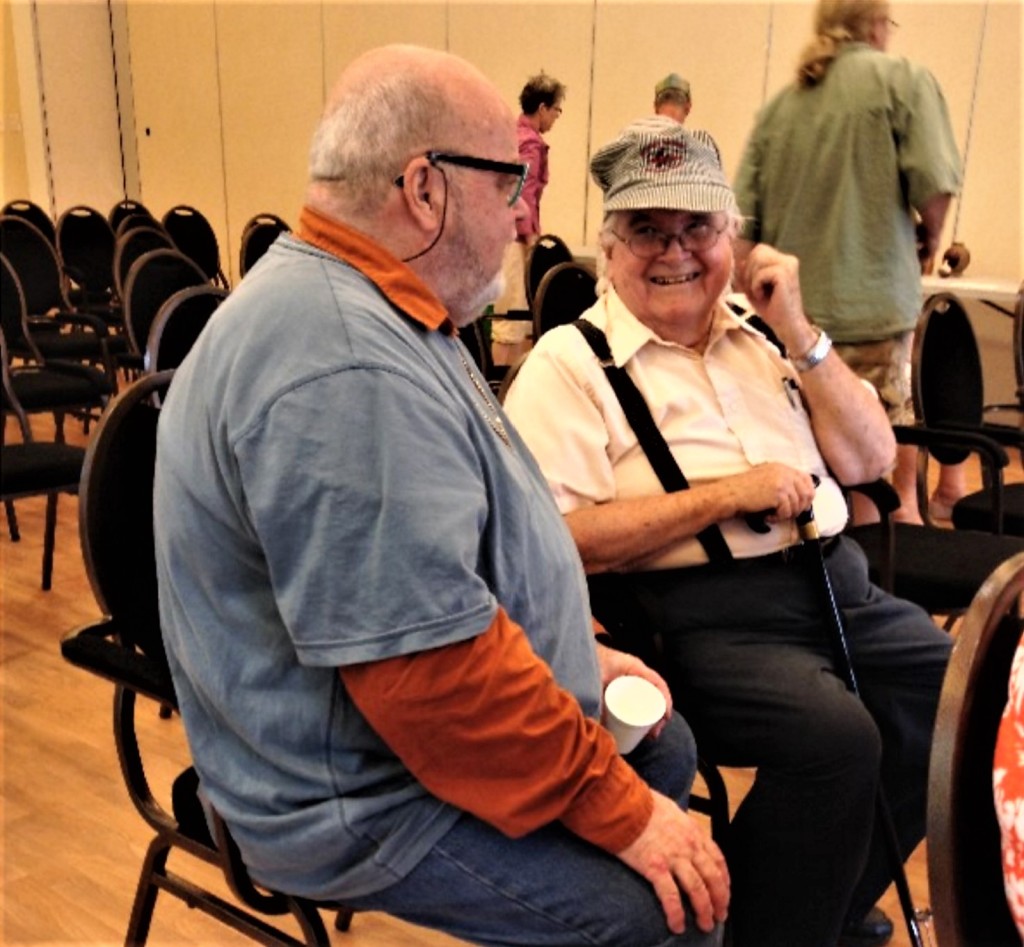
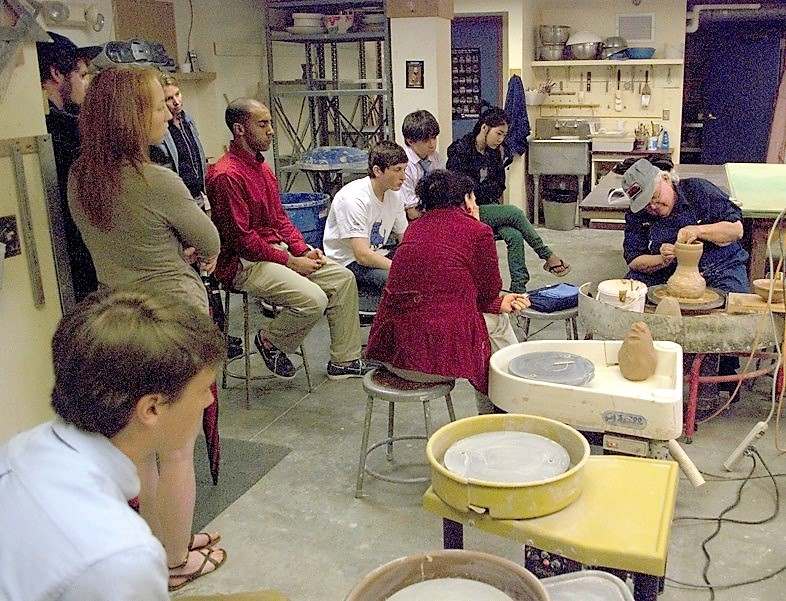
Remember, Dean was also a teacher. In conversations with some of his students one can get a sense of not only his teaching style and philosophy but also his thoughts on ceramics. There are many quotes of Dean’s in the literature on him.
Mullavey was a stickler for students being on time for class but generous to those wanting to work on their own time later in the day. When teaching at Champlain his class would start at 8: 30, when he would lock the door, and if you weren’t there, he wouldn’t let you in. Yet he would give keys to the studio to students who wanted to work later in the evening. 3
Not only did he teach the technical side of pottery, Dean also stressed the mindset of being a potter and the value of self-assessment. He would not give direct praise, rather snippets, “Oh, not bad”, “getting there”, “That’s interesting.” 3
Those were compliments. He taught integrity as the core between the student and the work:
“This work represents you. …Do what you love, what you are passionate about, and always do your best.” 3
But his approach to students enjoying the results of a kiln firing must have been frustrating at times:
“When a student’s work came out of the kiln he would say, ’Eh, you did it once, you could do it better’, and give the student a hammer. The expectation was that the student would go outside, break it and throw it in the garbage. It was about perfection.” 3
His technical approach was foundational but paradoxically, since he never operated his own studio, he taught that the studio was to be operated from the perspective of owning every aspect of it, the Mashiko-Hamada-Leach way: including beginning steps such as mixing dry clay, or later making students empty and repack the kiln to add two pieces.
Another Side of Dean Mullavey
Now that we have briefly looked at his life and influence I must comment on his non-potter life.
Mullavey adopted well to his new Canadian environment. He loved the stage, especially Gilbert and Sullivan:
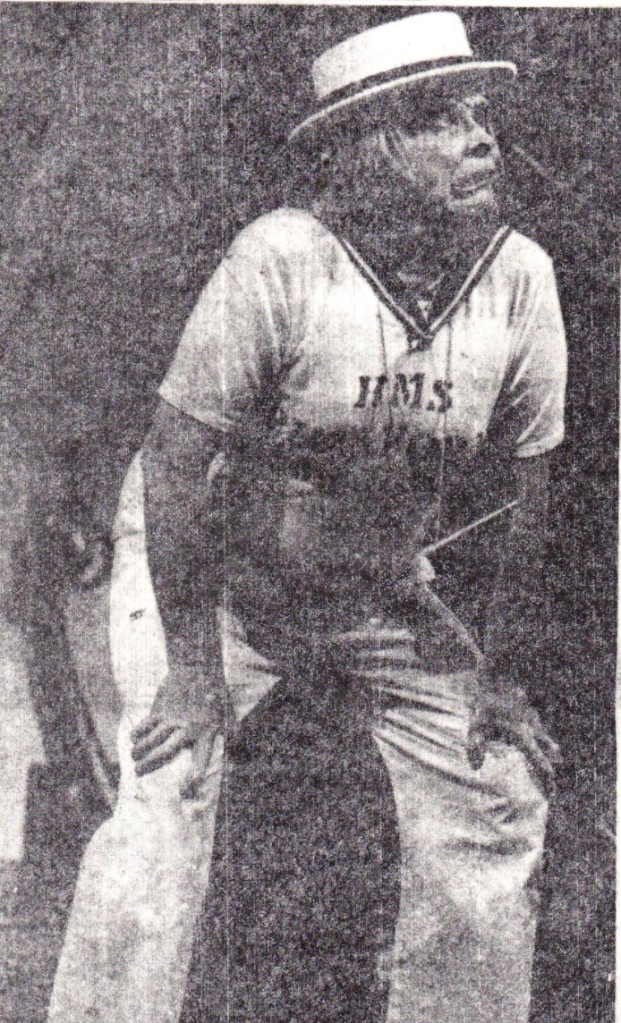
“He could be playful and had a wicked sense of humour, which may explain his infatuation with the operettas of Gilbert and Sullivan. He starred in many local productions mounted during the 1980s at Centennial Theatre in Lennoxville to benefit the local Volunteer Firemen’s Association. … Dean’s antics ensured there was never a dull moment for fellow cast members. Audiences adored his debut as Dead Dick Eye in HMS Pinafore, watched as he camped it up in Patience, and were entranced by his Lord High Executioner.” 12
Although he lived – and mostly taught – in Quebec for the rest of his life, Mullavey was a world traveller, and a collector of art pieces and artifacts on his travels. He also continued his interests in other art media: for example, he also displayed exhibitions of his etchings from photographs taken during his several trips to Egypt and Mexico in the late 1970s-90s such as “The Walls of Egypt” (“Les Murs d’Egypte”) in Lennoxville and Sherbrooke, QC.4
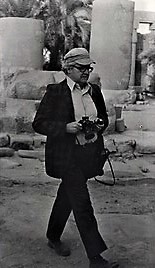
“Mullavey has tried his hand at a multitude of things, all related to collecting, antiques and art. As a matter of fact, for a short while he had his own antique shop in North Hatley and at one time was a recognised collector of decoys. … This many-faceted man also collects prints, tapestries, antiques and especially early American and French Canadian furniture.” 14
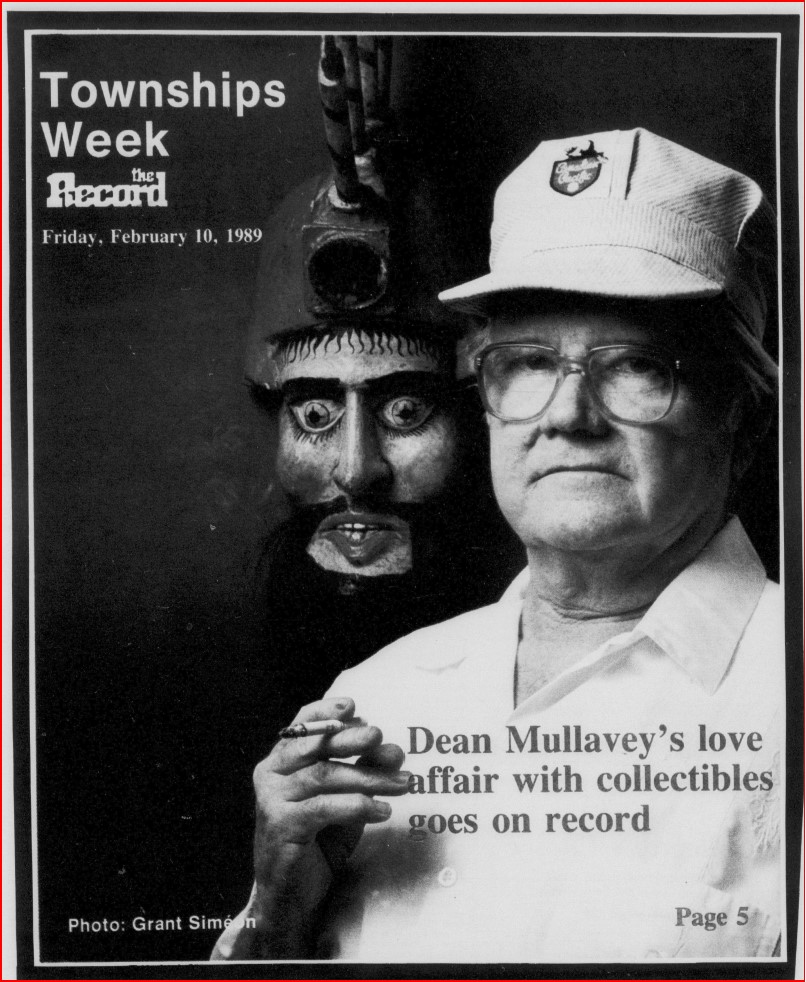
But some readers might have a personal question on “Why the train engineer’s hat he was always wearing?” The answer is elusive. Even his nephew Kevin Mullavey had to speculate:
“He just likes them. … He had some friends In Canada, who worked for train companies whom he would get to give him hats, but I think he just liked them and he didn’t like cutting his hair particularly. He used to tell me that he’d get his haircut once or twice a year whether he needed it or not. … I think the hat was an identity and I think it just kept the hair out of his face.” 4
Some mysteries may never be solved.
A Few Words on La Poterie (The Pottery)
Next, a few words about La Poterie—The Pottery—post Gaetan Beaudin’s departure, to provide some context for the milieu central to appreciating Mullavey’s influence. These few words might encourage someone to develop a more complete study of this influential school.
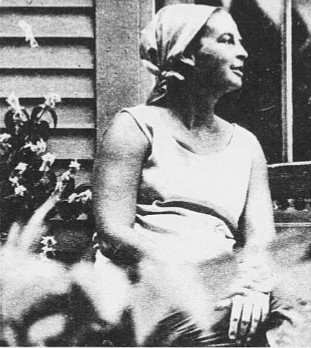
The school, located on the shore of Lake Massawippi, was started in 1954 by Gaetan Beaudin, and continued by his wife Mildred (Millie) when he left to develop SIAL. The school’s focus was on wood-firing functional pottery, a carry over from Beaudin’s experience. La Poterie was to become a seminal place in Canadian pottery, particularly Quebec. Millie was a magnetic force, a key element in many students’ memories.
” From the end of June to the beginning of September, three series of courses, each lasting three weeks, are offered to ceramic enthusiasts. The school, housed in a huge building, served as a hotel before it was occupied by the Beaudins. The house stretches the distance between two parallel streets clinging to the steep slope of the hill. … Since 1964, the Pottery has been under the direction of Mrs. Mildred Beaudin. Her original and fulfilled personality sets the tone for the relaxed atmosphere that reigns in the house. Dressed in a caftan and wearing a multicolored headscarf, she prepares dishes of unparalleled flavor. Weather permitting, meals are served on the outdoor gallery, in pottery dishes turned in the workshop.” 6
Dean was teaching there in 1966.
The early years of The Pottery had an initial simplicity about them. Early advertising was in a simple letter format. Student transportation options include information on train schedules from New York and bus service from Montreal. Students were expected from wide geographic and cultural areas.
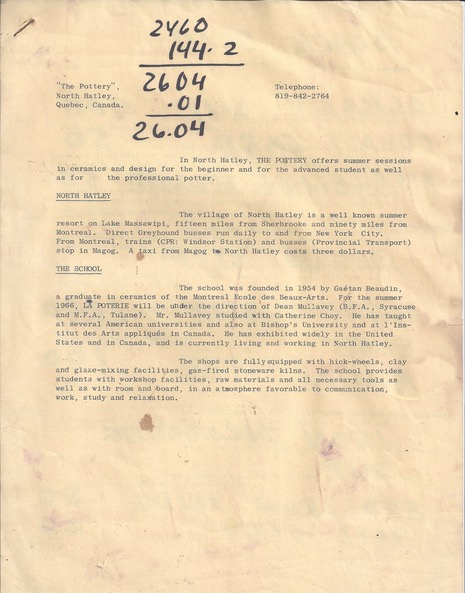
By 1980 the adverting and registration process had become more polished for the time.
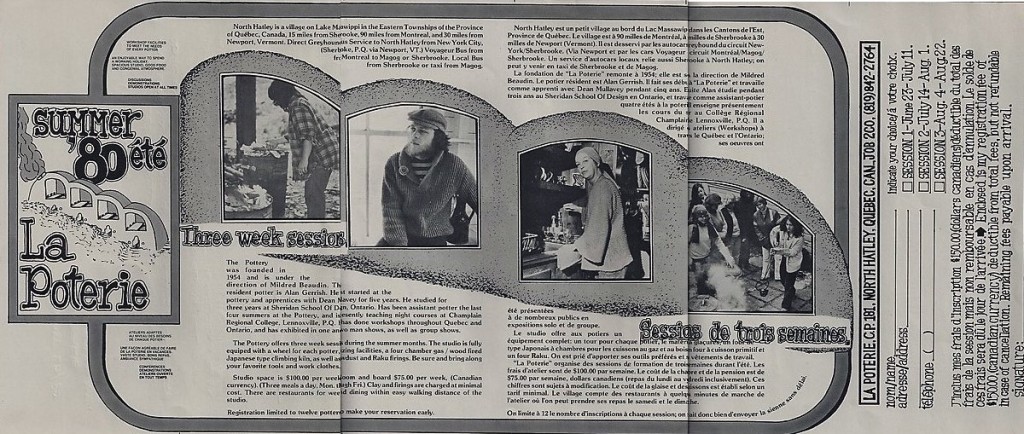
This brochure indicates a type of learning experience that not only provided room and board but also the technical facilities, including studio and room and board for $175 per week (plus “minimal” clay and firing fees for a three week session). It also illustrates on the left the studio’s four-chambered kiln, fired with propane and wood, the wood probably being used toward the end of the firing for fuller reduction effects.
The net effect of the whole entreprise was a devoted student following to The Pottery and Millie, and to Dean, that has lasted through the decades to this present day. For many, the experience in North Hatley was a peak life experience.
I repeat, the whole subject of The Pottery deserves a full academic study itself. The cast of visiting international and Canadian notables and is extensive.
A Gallery of Mullavey’s Work
Some inital thoughts and comments on Dean Mullavey’s Work
Mullavey’s work was, and is, so extensive that no matter how many works are shown any selection will seem incomplete. I’m sure there will be comments on what I should have included.
Firstly, a few points on Mullavey’s approach that indicate the consistency of his philosophy, style and techniques. Dean’s early years saw the foundation of his philosophy of pottery. This he passed on to his students. Some comments from various sources illustrate the consistency of his work and the devotion given by his students.
- the generally small size of Mullavey’s works give them an intimacy, a more personal presence, literally, that binds them to the holder. Visual appeal is important but to touch or to hold them is irresistible.
- he espoused the foundations of form and utility. ”For Dean the functionality was key. It was not a piece of art that you would look at then walk away from.” 3
- he was a thrower and preferred stoneware.
- he was not a mass production artist. He did create short series but was not an extensive production potter.3
- his preference was for reduction firing but towards the end of his career he did use an electric kiln, necessary because of his surroundings.3
- he did not like pots that were thrown heavy and trimmed to look “light”. 3
- the pot had to be “flying”, … the pot had to look like it has its own lift.3
- one of the wood fuels he used was recycled snow fences, conveniently precut into a useable sized fuel; plus he used ash from the city of Montreal in glazes. 3
- And, he never really had his own kiln facility, and often worked in other potter-friends’ studios.
Hal Halverstadt in his 1960 Little Gallery catalogue further recounts some of Mullavey’s musings and confirms Mullavey’s focus on form5:
- ‘” good clay form … has a right to exist by itself; the application of a glaze or decoration is a secondary matter. If a pot is to be admired for its color or decoration, then it is a failure. When I decorate a pot, I attack it quickly lest I change my mind and leave it bare.”
- “A pot has four dimensions. It is a hole surrounded by a three-dimensional form. The painter and sculptor work from the outside in; but the potter must work from the inside out, for the outside of a pot must conform with the inside form.”
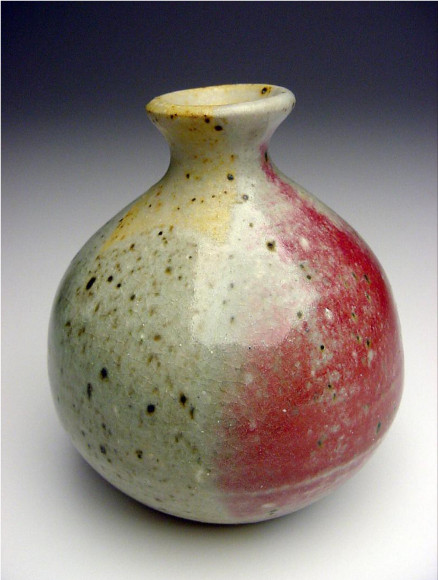
- “ I enjoy the asymmetry of a pot thrown casually and slightly off center.”
- “A wheel-thrown pot … should express the fluid and plastic quality of the material. It should retain the earthy nature of the clay and provide the tactile qualities so inherent in it.”
- “A pot beckons to be handled and provides a sensuous beauty of material. It can be rough and coarse, or it can be soft and smooth to the touch.”
In short, Dean Mullavey was recognized not only as a superb potter, but also as an inspiring teacher, even philosopher.
Dean Mullavey: Early Works 1950s-1960
NB: I have not been able to find any reference to architectural nor sculptural works. I could also find no indication he participated in the Quebec 1% program. If any reader knows of any examples please let me know
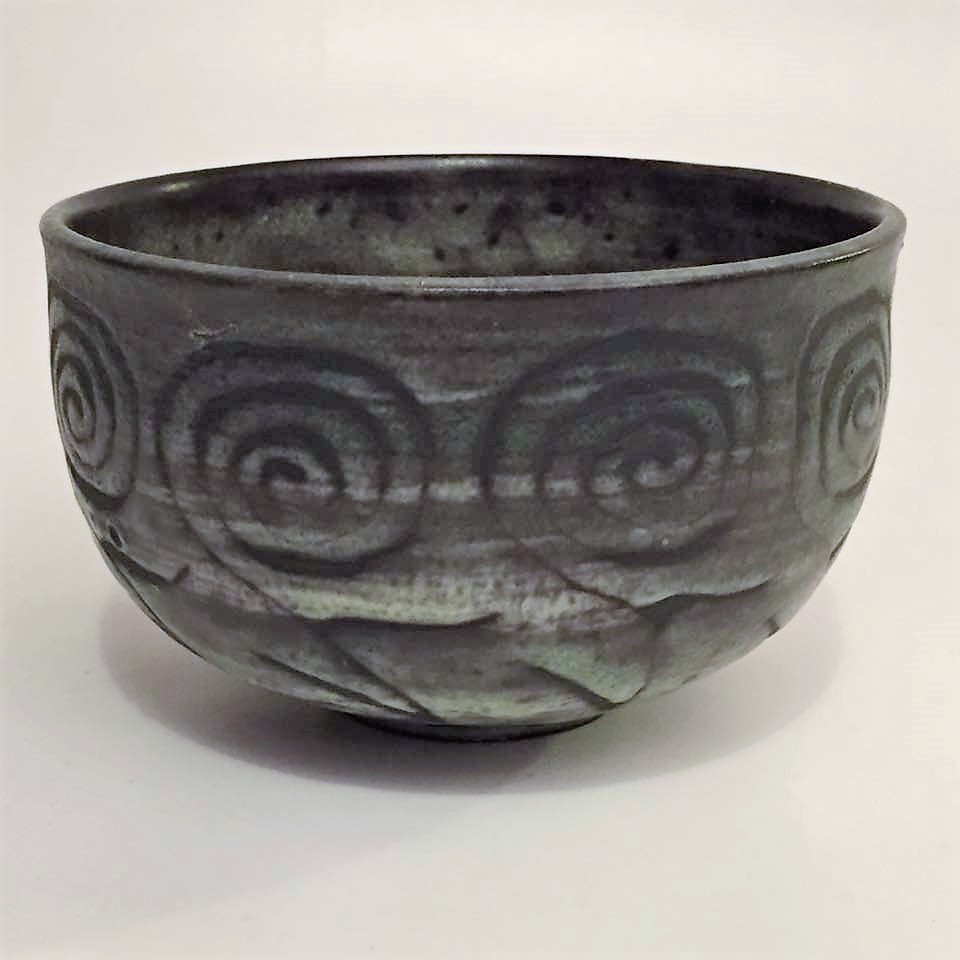
Kevin Mullavey, Dean’ nephew, provides this assesssment, and early Dean pot, on the influence of the Scheiers with whom Dean was working with at the time in New Hampshire.
” [He] pretty much wasn’t handbuilding … and everything was pretty straightforward: simple thrown items. And he told me once that that was in part a reaction to everybody else in the ceramic world doing all big stuff and he’s just like ‘to hell with that. I like making little pots.’” 4
Such works are simple, elegant with sgraffito or a brushed on glaze.
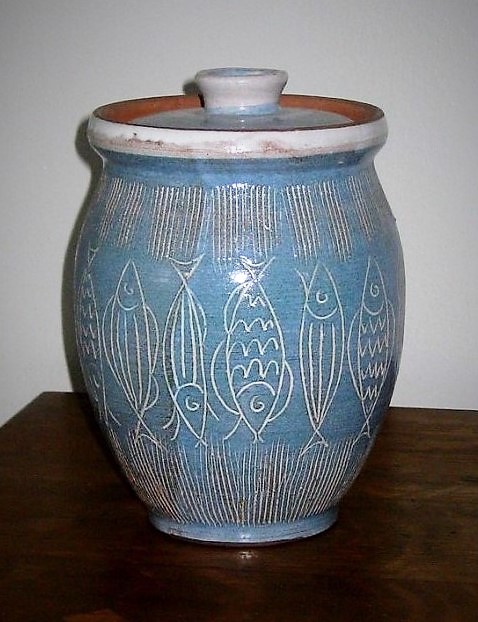
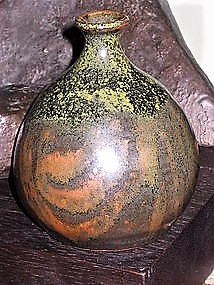
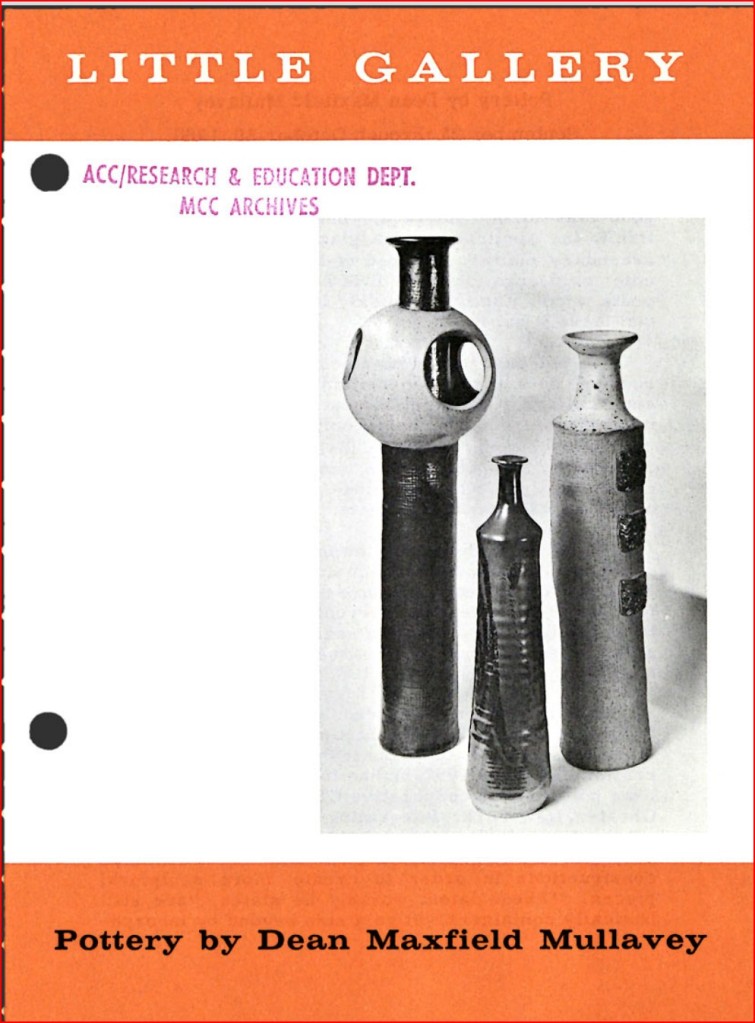
Although wheel throwing was his preferred vessel making technique, especially of a more ”intimate” scale, Mullavey did create larger works and some slab-type works especially earlier in his earlier career. Halversadt mentions this in the 1960 Catalogue, LITTLE GALLERY, Pottery by Dean Maxfield Mullavey,
”He works mostly on the wheel, only recently combining thrown components with slab constructions in order to create more sculptural pieces. These latest works,” …”are still basically containers, yet go a step beyond by incorporating both the technical and more imaginative abilities of the potter.” 5
The pots illustrated on the catalogue cover are a combination of thrown and assembled elements. He would move to preferred forms, the simple unity of a bowl and vase or bottle. By the 1960s, during his many travels throughout the U.S., he developed his signature dimensions and forms.
Canada: Lennoxville and North Hatley
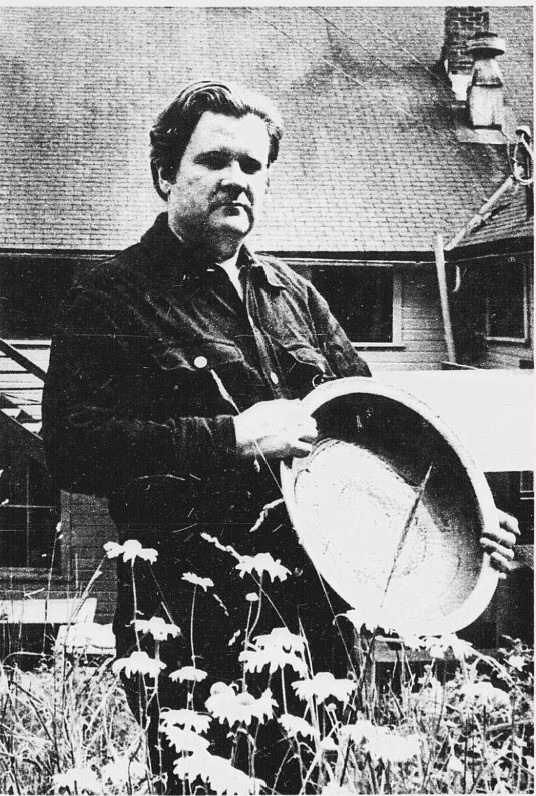
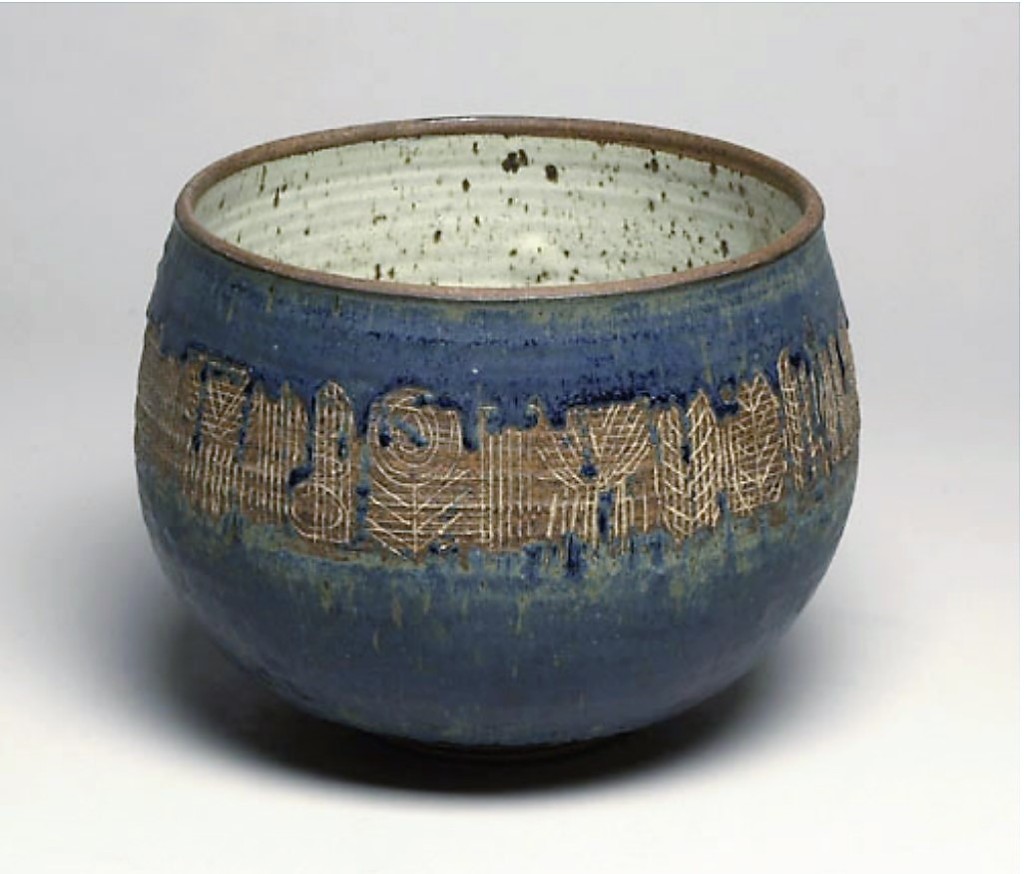
Although he is pictured here in North Hatley with a large bowl form, Mullavey had started the shift to more intimate forms, surfaces and dimensions that would bring him such renown. However, he could be more flexible for his students’ needs, changing his dimensional preferences and also loosening his separation of the functional and decorative, according to “student taste.” 6
An early Mullavey example is the “large” blue vase, above right, notable not only for its elegance of colour and sgaffito design but also for the fineness, the purity of the the thin bowl form and subtle curved lip.
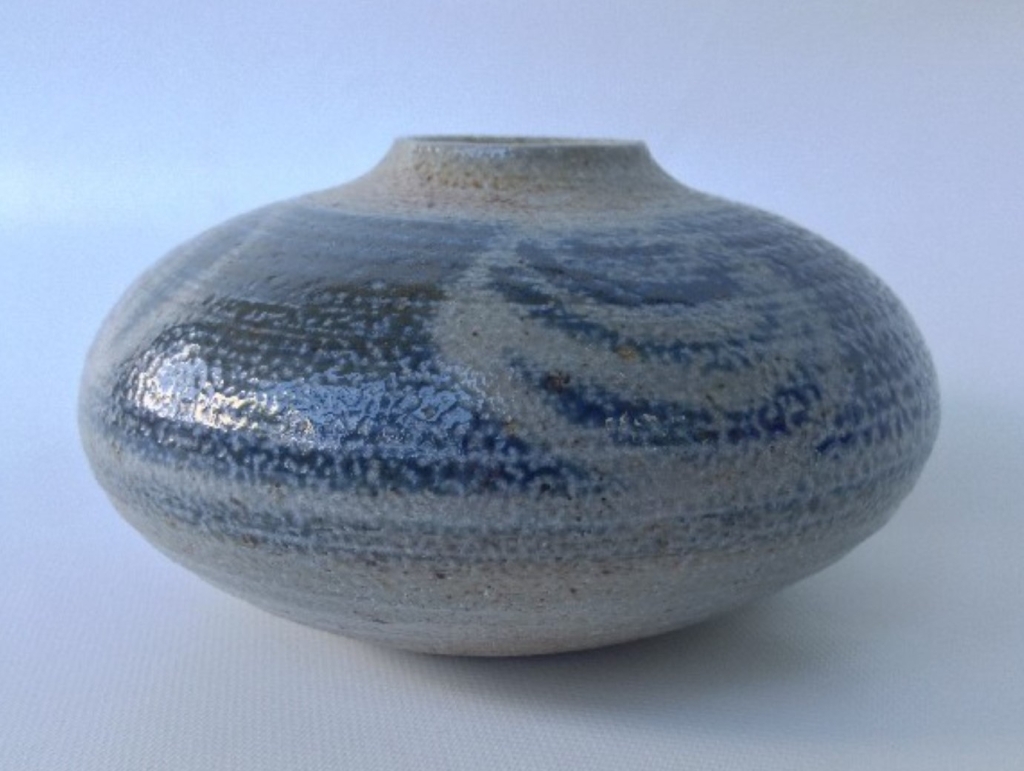
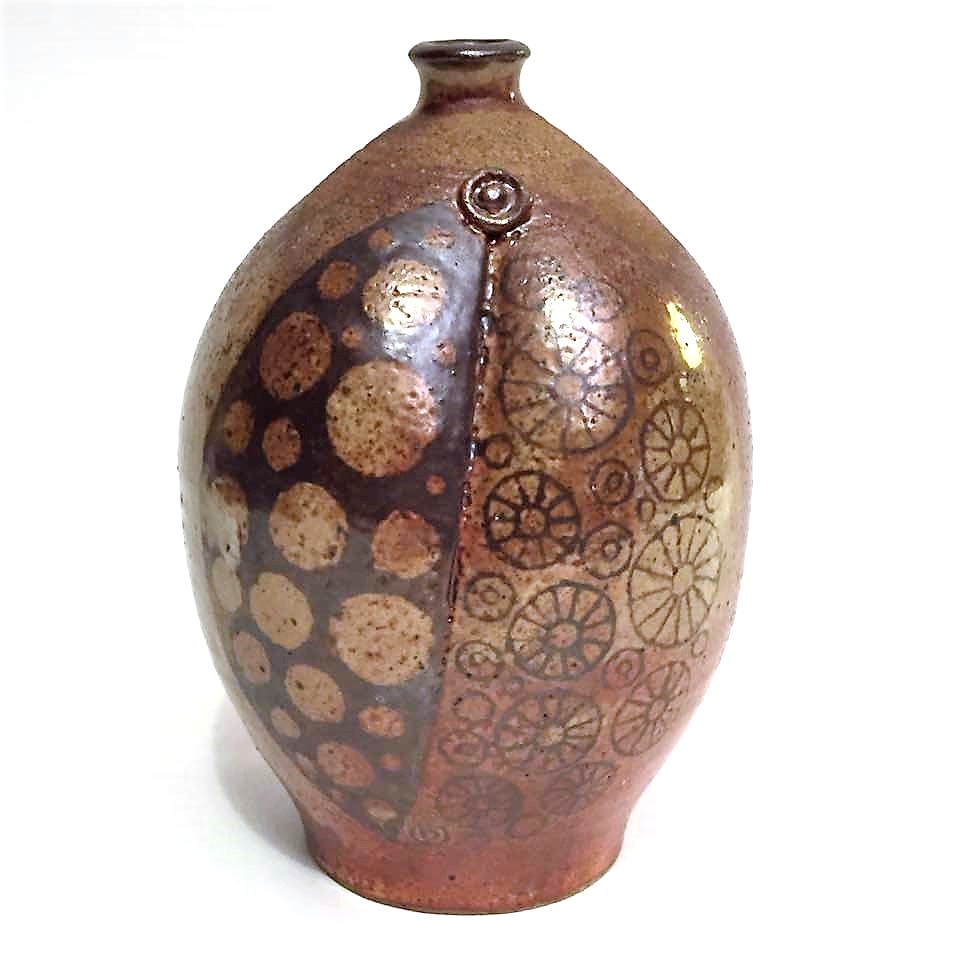
Although scale was a hallmark of Mullavey’s work, surface treatments were not necessarily so. Size might be consistently more intimate but colour, texture, additions and subtractions were still fair game for surface expression, frequently determined by the openness of the form itself.
The salt glaze surface and colour of the stoneware vase, above left, was fired in the Heino studio. The intimacy of the actual size would be an advantage in squirreling such work into a loaded kiln for a salt firing. Yet the image gives an illusion of a monumentality of form.
The 2011 shino glazed vase, above right, shows a a more complex display of subject and forms with a sprigging line separating contrasting backrounds of wheels and pitted circular forms: complexity in miniature.
Such works and styles leads us into a sampling of favourites from Mullavey collectors.
A Sampling From Collectors
Collectors’ pride, with multiple views of a work, provide a perspective on works that sales and exhibition catalogues often do not provide.
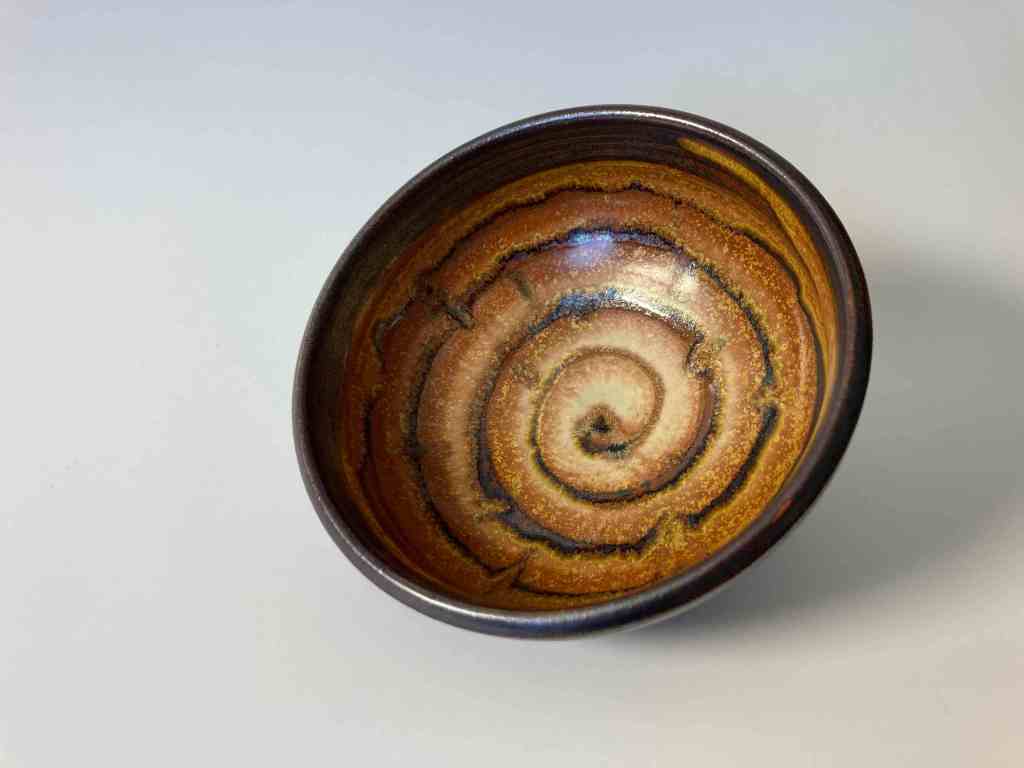
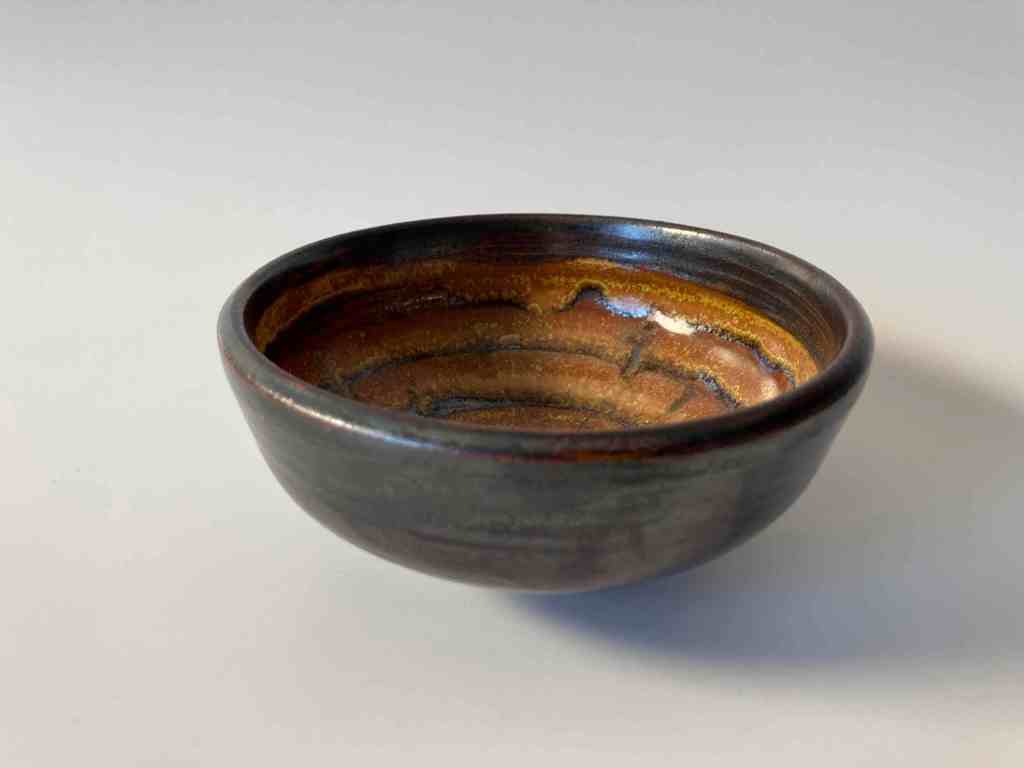
Dean Mullavey. Bowl. 6 cm tall, 12 cm wide. Probably white stoneware. Collection: Dan Hammill.
Above, a simple bowl in earth tones but with a simple exterior and a swirling, bleeding spiral.
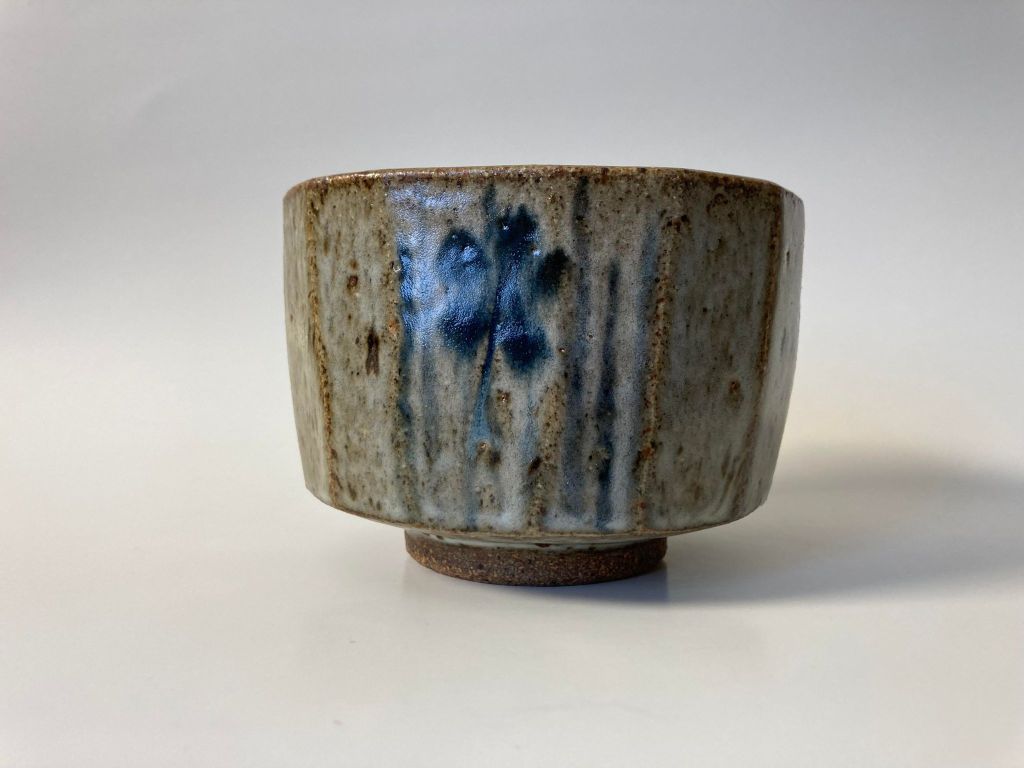
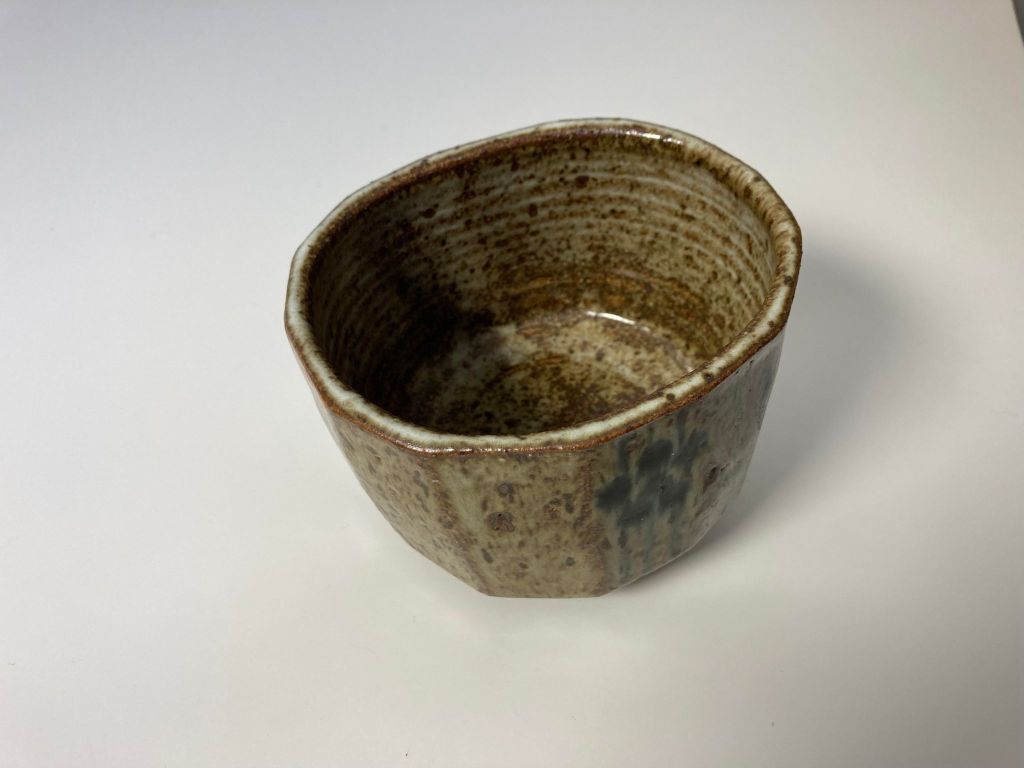
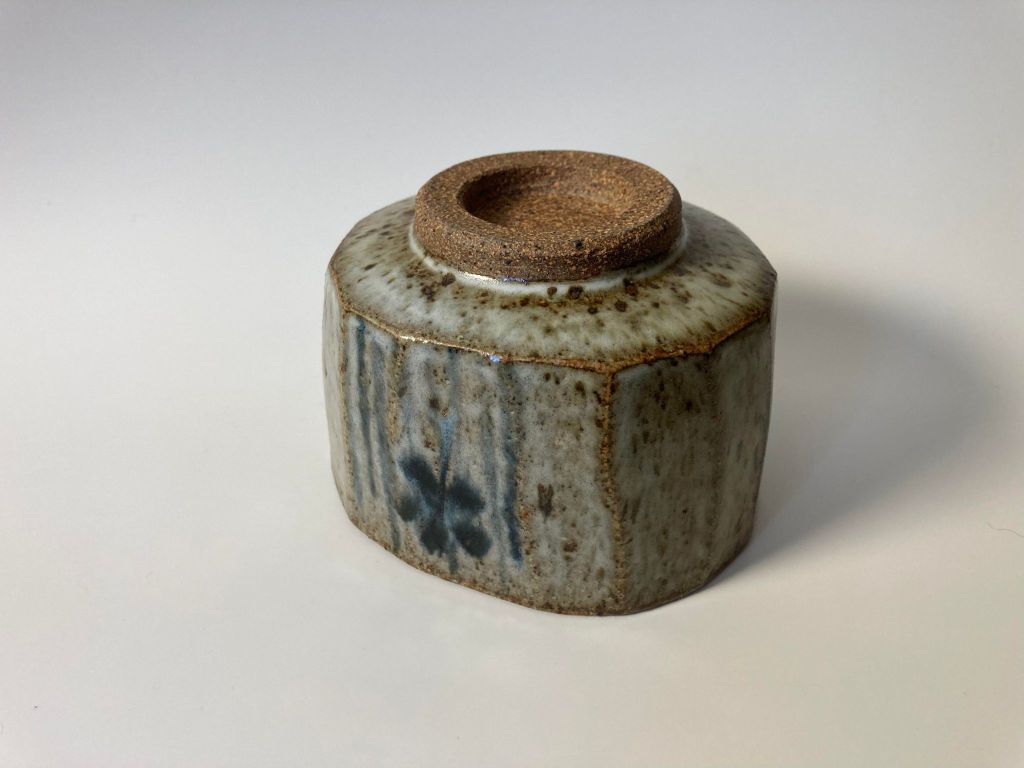
Dean Mullavey, nd. Cup. 8 cm tall, 11.5 cm wide, 10 cm deep. Stoneware. Collection: Dan Hammill
Above, what looks like a simple circular cup form on the left reveals itself to be of a gently angled geometry.
Also, Mullavey collectors, who are more than willing to share samples from their collections, generously provide examples of the most utilitarian creations that achieve the status of art. They also speak poetically of their collection and their use:
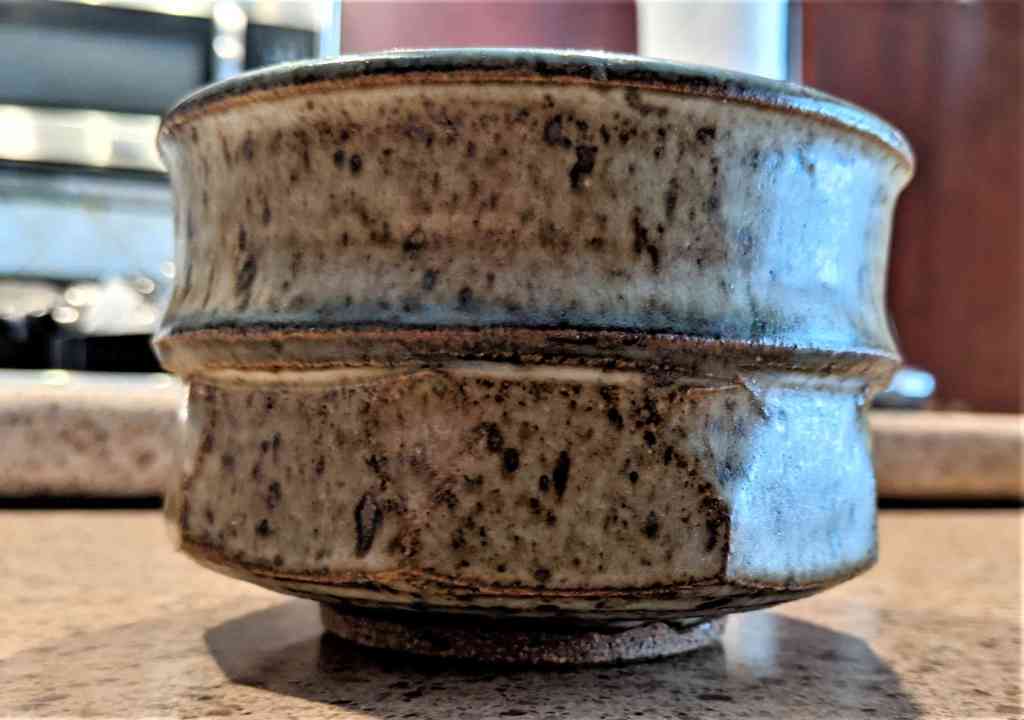
“Am having my morning coffee in a tea bowl with 10 facets. The various chawan Dean produced are beautifully crafted objects to use and love… The foot ring height fit and lip all in balance… From the inside out….” 3
Mullavey would continue to create the occasional form-outlier. He was an artist, after all.
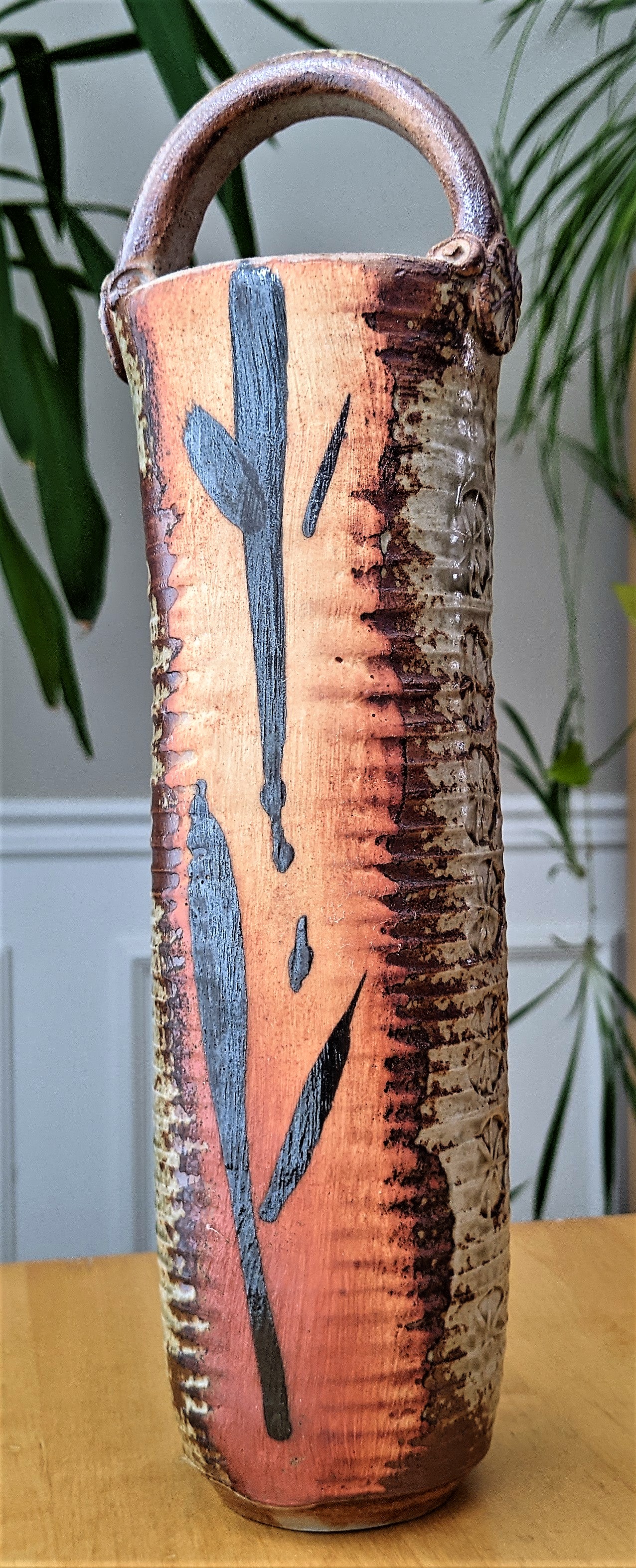
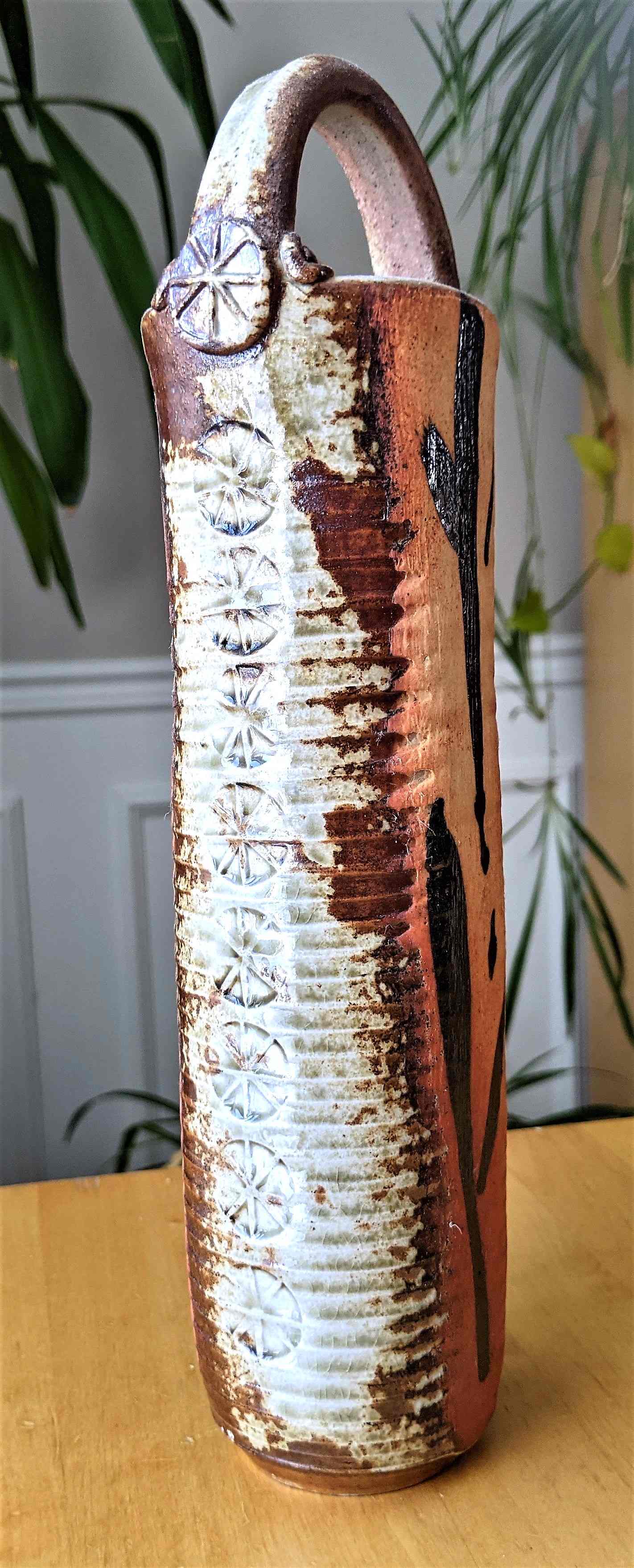
The above two sides of a handled-cylinder continues Mullavey’s play of different designs and styles depending on the angle of view. There is here an element of the creative outlier with its size and shape. The looseness of form shows throwing marks, some ridges smoothed by what appears to be paddling and stamping. The white glaze is applied as a wash that show the clay texture beneath, and on alternate sides as more thickly applied blackish leaf forms. The whole effect is one of Japanese inspiration.
But Mullavey maintains:
“As I get older my pots get smaller, but size is not important…its the form that counts.” 20
Finally, a few words and images on Mullavey’s mishima works.
Dean Mullavey’s Mishima Works
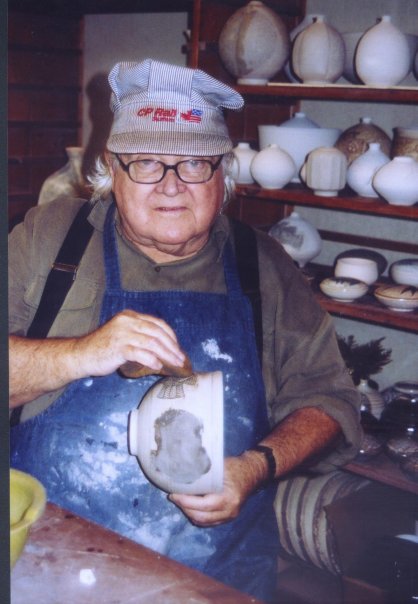
With mishima a scratched line on the pot surface is in-filled with colour. The rest of the surface is then buffed or wiped to remove the excess in-fill. While scratching into the clay or glaze surface is a common technique, Mullavey’s skill was probably enhanced by his studies and work in etching and wood engraving.
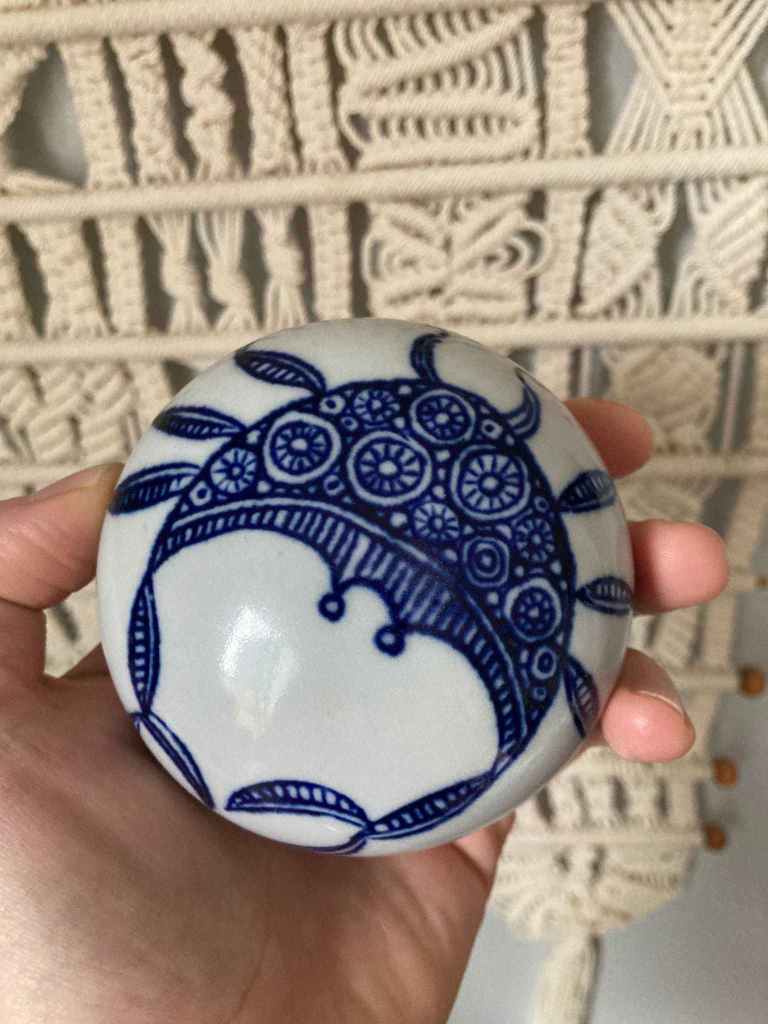
The paperweight on the right is included with the background to show scale of much of Mullavey’s work. Numbers on a page do not always carry the same impact as an image with a human element. The Bird in the Bush below shows a similar use of sun-discs and parallel lines and curves. The detail and precision are remarkable on such small or tightly curved surfaces. Design balances form and seems to emerge from the pot shape.
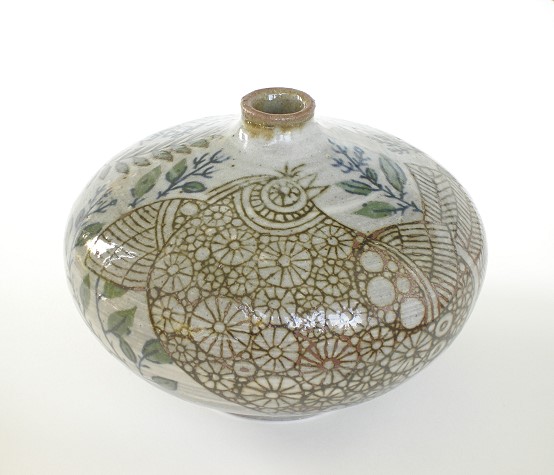
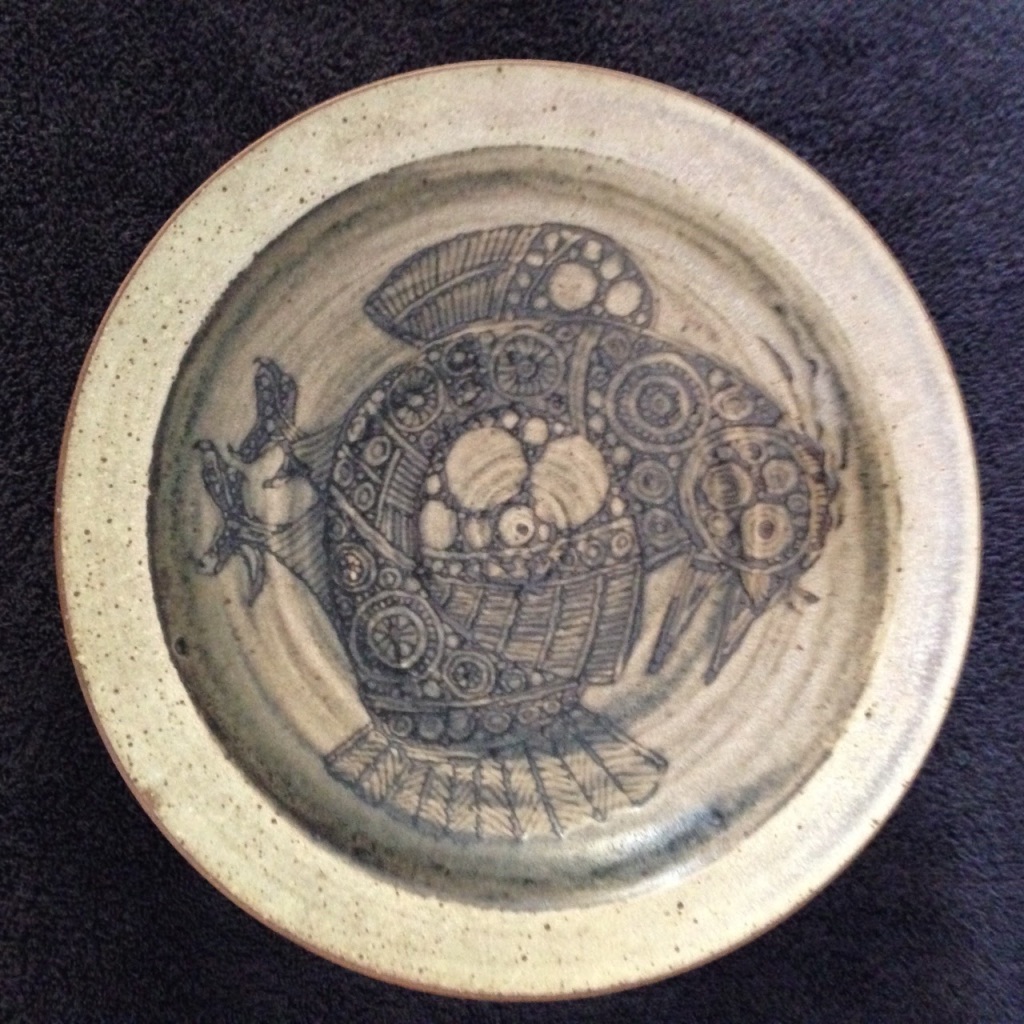
In such monochromatic works Mullavey could depict the complexity of the universe: fins, rays eyes and planets contained within the circumference of a bowl rim. Infinite within the finite. These hint at the further depths of Dean Mullavey’s inner self.
Closing
There are some artists whose following extends beyond their art. They seem to have a following that appreciates, sometimmes almost idolizes the person behind the art. Dean Maxwell Mullavey falls into that category. There is nothing simple about Dean or his work—his creations, his love of life, his connecting with students and other artists. His work is complexity and depth in simplicity and scale.
Mullavey’s death in 2015 affected many of his students and collectors in a way seldom seen for other artists.
“We’ve all been charmed by his humor and outspokenness, his liveliness and his great generosity. We are several members of the ACCQ to recognize the important legacy of this ceramic artist who marked the second half of the 20th century through his exceptional work, his know-how and his teaching.” 15
Endnotes & Bibliography:
- Correspondence with Dean Mullavey, sent to Barry Morrison, c.1981.
- Telephone Interview with Oliver Drerup, June 30, 2020
- Telephone Interview with Phillippe Bilodeau, February 26, 1921
- Telephone Interview with Kevin Mullavey, May 24, 1921
- Halverstadt, Hal. Little Gallery Catalogue: Pottery by Dean Maxfield Mullavey September 23 through October 30, 1960. Museum of Contemporary Crafts of the American Craftsmen’s Council. LITTLE GALLERY https://digital.craftcouncil.org
- O’ Neil, Huguette. LeDroit. Perspectives. Vol 10, No 37. 14 septembre 1968;pp. 8-13 ( Law, September 14, 1968, Notebook 2) https://numerique.banq.qc.ca/patrimoine/details/52327/4215420
- Remembering Dean Mullavey Facebook page: https://www.facebook.com/dean.mullavey
- Barbe, Marilyn. London Potters Guild Newsletter POTTERS NEWS. Vol. 28, No. p.1.
- Living Ceramics: The Art of Vivika and Otto Heino. Studio Potter.Tuesday, September 13, 2022. https://studiopotter.org/living-ceramics-art-vivika-and-otto-heino
- McGowan Fine Art Gallery. Resume for Dean Mullavey. http:www.mcgowanfineart.com/mullaveyresume.html. URL no longer active.
- Remembering Dean Mullavey. Facebook page https://www.facebook.com/dean.mullavey
- Pressreader Dean Maxfield Mullavey. July 14, 1927-December 27, 2015. Sherbrooke Record 7 Apr 2016. https://www.pressreader.com/canada/sherbrooke-record/20160407/281556584977983
- Victoria Jones Dean Mullavey page Facebook . HMS Pinafore picture facebook https://www.facebook.com/dean.mullavey
- Claudia Villemaire. Townships Week—Friday, February 10, 1988. Dean Mullavey and one of his favorite collections.
- jeanfranco27. AntiquePromotion Québec. Re: Dean Mullavey 1927-2015 Posté par le 31/12/2015 10:58:15. http://www.antiquepromotion.com/modules/newbb/print.php?form=1&topic_id=3507&forum=32&order=ASC&start=0
- Staff Writer. Three Holderness alumni exhibit at Edwards Gallery. Fosters Daily Democrat. April 15, 2010.
- Dan Hammil correspondence.
- Forum – Artisans céramistes du Québec – Dean Mullavey 1927-2015 : Antiquités Antiquaires Collectionneurs Québec AntiquePromotion. https://www.antiquepromotion.com/modules/newbb/viewtopic.php?topic_id=3507&forum=32&post_id=23039#forumpost23039 A great source for Quebec potters of all kinds and periods.
- Elizebeth Seabrook photo via email
- Vasefinder International: http://vasefinder.com/
- Antique Promotion Quebec Re: Dean Mullavey 1927-2015 Posté par jeanfranco27 le 31/12/2015. https://antiquepromotion.com/modules/newbb/print.php?form=1&topic_id=3507&forum=32&order=ASC&start=0
© March 2024 studioceramicscanada.com
